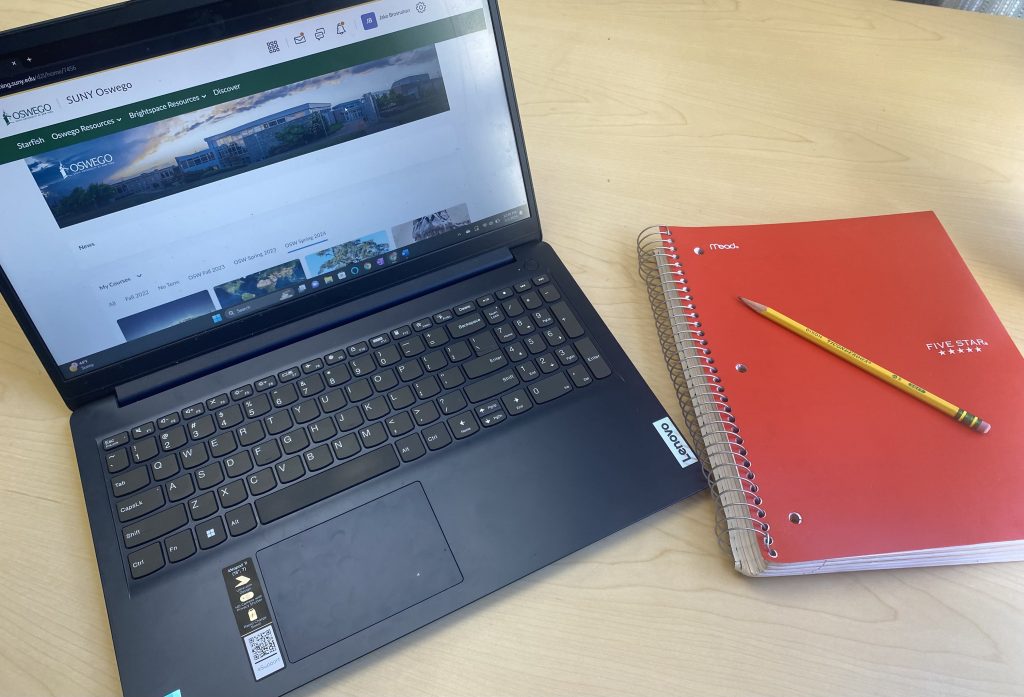Online learning continues to grow in years after COVID

Oswego, NY — The popularity of online courses among college students has seen steady growth following the COVID-19 pandemic from 2019-2021, a new study shows.
According to the study by Wiley Journal Insights, a journal review website that studies trends in the market, 79% of students surveyed are open to a synchronous virtual learning session at least once per course.
Experts believe the cause of this continuing growth is exposure to online learning during the COVID-19 pandemic.
“Even as the pandemic subsides, learners’ experiences with synchronous video technology, such as Zoom, appear to have inspired greater acceptance of synchronous learning opportunities in online programs,” the study says.
Gregory Ketcham, an assistant dean of Extended Learning at SUNY Oswego, believes that the pandemic created a bubble in the growth of online learning at Oswego.
“As fall 2020 happened, we went from 20 hybrid courses to 370 hybrid courses. We went from 182 fully online to 491 online because we had to shift everything around,” Ketcham said.
Schools offered virtual learning courses previous to COVID-19 but drew mostly graduate students and not many first-year college students. The study found that 59% of participants that enrolled in an online course between 2020-2023 aren’t likely to change to a campus-based program in the future.
SUNY Oswego offers online courses through its Extended Learning program, as it has done for years. The program offers a way for non-traditional students and adults to pursue learning and enhance new skills for those who can’t make a college schedule work for them. .
In the year following the bubble, comparing fall 2019 to fall 2022, SUNY Oswego has four times the number of hybrid courses and almost doubled the number of fully online courses from 180 to nearly 300 courses. Ketcham attributes this growth to the exposure to online learning that students received during the pandemic when students experienced the convenience and the flexibility of online courses for student’s schedules.
“Every now and then this question comes back around to me, ‘How do I know that students aren’t just living in their dorm in pajamas taking all of their classes online.’ Whenever I’m asked that question I look at the enrollment patterns and I can tell you that a lot of students have one maybe two online courses as a way to make their schedule work for them,” Ketcham said.
Apart from its use to current students, Ketcham says that online learning also gives an advantage to adults who want to pursue new skills for their future careers through their Integrated Professional Studies program.
“It’s really designed for adults who are thinking about a career change but also thinking about what sort of skills do I need with this changing workforce and economy. It’s a way to sort of future-proof yourself through this degree,” Ketcham said. The IPS program currently has 40 students compared to the seven it had when it started in 2022.
Students have taken well to online learning, but questions about academic expectations and learning quality have been raised. According to the study, a quarter of respondents have expressed concerns about expectations, lack of instructor interactions, and instruction quality during the course of their online learning.
Online learning gives students the temptation to not take a course seriously because of the online aspect of it, there’s no responsibility to go to class and take notes when the main goal of these classes is to only do work.
“Being together in some ways, it creates a sense of community and sometimes that community can help to hold you responsible to make sure that you get through your learning activities. Then when you’re online you’re the one who’s holding yourself accountable and you may create a virtual community, you certainly can form connections with people you’ve never seen, we all do that through social media don’t we?” Ketcham said.
Andrew Peterson, a student at SUNY Oswego, takes a majority of his courses online and believes he receives information better through in-person courses rather than online.
“These online courses don’t really allow me to communicate with my professor or my classmates. In some courses it feels like it’s just assignment after assignment until we reach the end of the year,” Peterson said.
Many students feel that their participation in these courses may help their grades but experience trouble understanding the information taught in the courses.
“I had to take a class where I took the prerequisite online and when I went into it a lot of the content had to do with the class I just took and I didn’t really understand because I took it online,” Peterson said.
As the landscape of education shifts post-COVID, the debate on online learning promotes the need for an approach that balances its benefits and challenges so an effective educational experience can be reached for students nationwide.